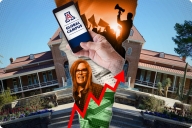You have /5 articles left.
Sign up for a free account or log in.

Istockphoto.com/exdez
Thousands of students nationwide still don’t have access to a fast and stable internet connection in their homes despite huge advances in technology in the past decade.
Whether it's a lack of technology infrastructure, particularly in rural and remote areas, or prohibitive monthly costs for high-speed internet service, students without access at home have a harder time doing homework and often fall behind their peers that do have access.
Educators and policy makers have grappled with this so-called homework gap for decades as online learning became more integrated into secondary school and college curriculums. But there is now a possible solution: the Educational Broadband Service, or EBS.
The EBS is a 2.5 GHz-frequency spectrum that could be used to create high-speed wireless broadband networks in rural communities, but educators and policy makers are divided over how best to achieve this.
Several school districts and colleges in rural areas want to take matters into their own hands by deploying their own wireless broadband networks for use by local residents. But some policy makers and experts have argued it would be more effective to sell the EBS spectrum to telecommunications companies and use the proceeds to fund government-led initiatives to close the homework gap.
Fred Campbell, director of Tech Knowledge, a technology policy think tank, wrote a recent report outlining why auctioning off the EBS and creating a needs-based subsidy for underfunded K-12 schools is the best way forward.
There are around 1,300 nonprofit organizations, schools and colleges with EBS licenses, yet Campbell argues the spectrum is not being used to its full potential.
The FCC estimates that about 90 percent of all EBS license holders lease their spectrum rights out to commercial wireless service providers such as Sprint and use the payments as a revenue source. Campbell, who formerly headed the FCC's Wireless Telecommunications Bureau, described this practice as an "implicit federal subsidy" for the "lucky few" institutions that got EBS licenses more than 20 years ago. He noted that at least 20 universities with endowments of more than $1 billion, such as Emory University in Georgia, Purdue University in Indiana and Ohio State University, hold EBS licenses. Many of these institutions are leasing out their spectrum and pocketing the proceeds, he said.
Institutions have been permitted to lease out their spectrum since 1983, on the condition that they retain 5 percent of their capacity for educational use, but the requirements for meeting this condition are unclear, said Campbell. The 2.5-GHz spectrum was earmarked for educational use by the administration of President John F. Kennedy in 1962.
Dozens of universities contacted by Inside Higher Ed declined to say how much money they make from their leasing arrangements, but Campbell said these institutions can earn hundreds of thousands of dollars per year.
“It does not serve the FCC’s mission of the public interest to subsidize the general operations of these elite institutions and other well-funded school systems at the expense of closing the homework gap for K-12 students in rural and underserved communities,” he wrote in his paper.
The FCC could break the existing lease agreements, but Campbell lays out the framework for a voluntary auction in which EBS license holders could choose to participate. He argues that institutions should be paid a lump sum, in exchange for their licenses, that is several times higher than what they might earn from leasing out their spectrum over a 30-year period.
Rethinking the EBS
The idea of auctioning off the EBS appears to be gaining momentum. The Internet Innovation Alliance -- a coalition of businesses (most notably telecom giant AT&T) and nonprofits that advocate for broadband expansion -- held an event in January discussing how such an auction might work.
“The great promise of using this spectrum for educational purposes has really not lived up to its potential,” FCC commissioner Jessica Rosenworcel said at the January event. “Why don’t we give those who hold these licenses a choice?”
Institutions could choose to hold on to their licenses under the same terms, or they could choose to “sell them back to the agency,” she said.
“We can repackage all those licenses that are sold to us and sell them out for broadband use. Then the revenues from that can be used to fund homework gap initiatives in every state,” said Rosenworcel. “I think that honors the legacy that the Kennedy administration worked so hard to set up. But it does it in a totally modern way.”
FCC commissioners have been considering for more than a year how the EBS can be used more effectively. A notice of proposed rule making was published by the commission in May 2018, proposing to provide “greater flexibility to current EBS licensees as well as providing new opportunities for additional entities to obtain unused 2.5-GHz spectrum.”
The FCC began issuing EBS licenses in the 1960s, when the spectrum was known as the Instructional Television Fixed Service and was used to broadcast educational television programs. As technology evolved, so did the possible uses of the 2.5-GHz band. The spectrum is now a valuable asset that can be used to achieve superfast download speeds through fifth-generation cellular networks, known as 5G.
The FCC stopped awarding EBS licenses in the mid-1990s, when it became clear that few institutions were still broadcasting educational television programs. The existing EBS licenses cover approximately one half of the geographic area of the United States. There are large areas, particularly rural areas with few people, where the 2.5-GHz spectrum remains unassigned. These areas are known as "white space."
Over 300 comments have been submitted to the FCC's proposed rule regarding the future of the EBS. Many of the comments are from educational institutions asking the FCC not to auction off the spectrum. Several groups said they wanted the opportunity to apply for new licenses and create their own homework gap solutions. The FCC is currently reviewing the comments and is expected to respond later this year.
A joint comment from the National EBS Association (NEBSA) and the Catholic Technology Network, which both represent a large number of EBS license holders, argued that an auction is the wrong way forward. The groups said in order to best take advantage of the spectrum, the FCC should issue new licenses to educators and tribal nations in rural areas where none are currently assigned.
“While unassigned EBS spectrum should be licensed and some modernization of the EBS rules may be warranted, a ‘transformation’ of the band is neither necessary nor in the public interest,” Lee Solonche, executive director of NEBSA, said in an email. “EBS does not need fixing. It needs finishing.”
A Call for New Licenses
Jim Stewart, chief technology officer at the Utah Education and Telehealth Network (UETN), a statewide organization that provides internet infrastructure for schools, higher education institutions and hospitals, is among those hoping the FCC will start granting new EBS licenses and decide against an auction.
UETN had EBS licenses but decided not to renew them back in the ’90s, said Stewart. “We just weren’t using them and didn’t see any advantage in trying to keep them at the time,” he said. Now UETN is trying to get them back.
In addition to improving internet connectivity for students in their homes, UETN wants to use the EBS spectrum to improve internet access on school and college campuses. Many Utah institutions have strained Wi-Fi networks because of the large number of devices students and staff use on campus. Stewart wants to introduce 4G, or perhaps even 5G, wireless broadband connectivity. But to do this, UETN needs the EBS spectrum.
Stewart has met with FCC representatives to obtain a waiver that would allow UETN to get an EBS license, but he has been unsuccessful so far.
“We can’t move forward, we can’t do anything,” he said. “What we’re really concerned about is that this will be auctioned off and that will be the end of it.”
Eric Smith, director of broadcasting and audiovisual services at Northern Michigan University, successfully applied for a waiver to obtain a license about 10 years ago. Now the university is able to offer wireless broadband internet service to several towns in Michigan’s Upper Peninsula.
The NMU Educational Access Network is open to anyone who wants to access the internet for educational purposes, said Smith. Area residents with no affiliation to local colleges, universities or schools can sign up for $34.95 a month on the condition they complete one of the university’s free adult education classes. Students and families with schoolchildren can sign up for $19.99 a month. Over 3,800 households have signed up, said Smith.
He said the monthly fee does not generate revenue for NMU but covers the costs of equipment the university purchased to make self-deployment of the wireless broadband network possible.
Smith would like to see other institutions, particularly in rural areas, deploy their own networks. But they can’t do that unless the FCC opens up applications for new EBS licenses. Like Stewart, Smith is skeptical that auctioning the spectrum to commercial entities would have the same benefit as institutions deploying their own networks.
“There are great opportunities for self-deployment that never existed before,” he said.
Patrick Gossman, deputy chief information officer at Wayne State University, agrees the FCC should give institutions the opportunity to deploy their own networks. Equipment costs have now come down significantly, and projects such as the NMU Educational Access Network have shown it can be done, he said.
Gossman said the EBS is being used effectively by educators.
“The only spectrum not being utilized in the United States is the spectrum that the FCC has been sitting on for over 23 years, despite all the efforts we’ve made to get them to license the unlicensed areas,” he said.
Wayne State University obtained its EBS licenses in the 1960s and produced educational television programming until the 1990s. It then leased its spectrum to Sprint, which built up the necessary infrastructure in Detroit to make the 4G LTE network operational.
“There was no way that I could have built a cellular 4G LTE network to blanket 38,000 square miles and four million people. It made a heck of a lot more sense to partner with Sprint and let them go through that,” said Gossman. “We lease to Sprint, but I look upon it as a partnership.”
Gossman was unable to share the value of WSU’s lease arrangement with Sprint due to nondisclosure agreements, but he said the money is used to create educational programming and provide digital devices to local schools.
“We didn’t get into this for the money; we got into this to provide educational services,” he said. “Yes, the spectrum has become valuable, yes, we make money, and yes, we make good use of all those funds.”
He said no amount of money would convince WSU to sell its spectrum.
“In education, one-time funds evaporate. Getting a steady income stream is extremely valuable.”
Gossman said he struggles to see how auctioning off the “white space” would meaningfully improve internet connectivity in rural areas. “The incentive just isn’t there for commercial entities to build,” he said.
“For an auction to work, you need somebody who wants to sell and somebody who wants to buy. It’s not clear to me that they’d find buyers -- the EBS spectrum is all chopped up.”








